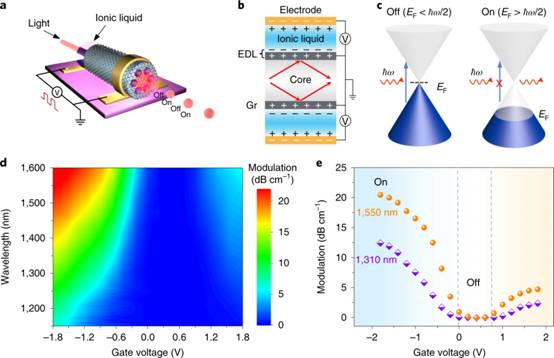Prof. Chen Ke has made important progress in the research of graphene photonic crystal fiber materials and optoelectronic devices in close cooperation with the research team of Academician Liu Zhongfan and Prof. Liu Kaihui of Peking University. The related results were published online on August 12, 2019 in Nature Photonics under the title of "Graphene photonic crystal fibre with strong and tunable light-matter interaction" (DOI: 10.1038/s41566-019-0492-5, impact factor 31. 583). Prof. Chen Ke is the first author of the paper, Academician Liu Zhongfan and Prof. Liu Kaihui are the co-corresponding authors, and Henan University is the second signed unit.
In the past 60 years, special optical fibers represented by photonic crystal fibers (PCFs) embody the milestone progress in the development of optical fibers. Compared with traditional non-cut-off single-mode fibers, it has extremely rich functions beyond traditional fibers, and is widely used in supercontinuum light sources, optical frequency combs, optical soliton propagation, high-power pulsed lasers and other fields. The delicate periodic porous structure of PCF enables it to be compounded with a variety of functional materials including gases, liquids, solids to liquid crystals, extending its application in mode-locked fiber lasers, laser frequency converters, surface plasmon generation, and fiber-optic electro-optic modulators and other new features of the device.
Graphene has unique intrinsic properties such as massless Dirac fermions and linear dispersion relations, and exhibits the advantages of ultra-high carrier mobility, broadband optical response, and electric field tunability. The rise of graphene has naturally stimulated a strong interest in fusing PCFs with 2D materials. Previous studies usually involve transferring graphene films to the surface of optical fibers, or filling graphene powders into PCF holes to realize the preparation of graphene/fiber composite structures. However, these attempts are only at the level of laboratory preparation. The integration area of graphene and optical fiber is very small, and the optical coupling efficiency is low. There is still a big gap between large-scale production and industrial application of materials.
In this work, it is proposed for the first time to prepare graphene photonic crystal fiber (GR PCF) with lengths up to half a meter by chemical vapor deposition. The feature of this method is that it can realize the direct in-situ growth of graphene films of different thickness and uniformity in the inner micro-channels of PCF.. According to the traditional graphene growth theory, it is very difficult to directly grow graphene in long-distance PCF micron-scale pores without the participation of metal catalysts. In order to keep the fiber structure and function unchanged, no metal catalyst was introduced in the graphene growth process. Instead, according to the hydrodynamic theory of gas, the molecular flow model of the reactive gas is used to design the experimental conditions, which breaks through the non-catalytic growth bottleneck of graphene in the threshold space, and successfully realizes the uniform growth of high-quality graphene films on the inner wall of the channel (Figure 1). ).

Figure 1 Controlled preparation of graphene photonic crystal fibers
Based on this special composite structure, Gr-PCF achieves strong light matter interaction, and the light attenuation coefficient as high as 8 dB cm-1, which is is much higher than that of single-layer graphene. Adjustable light-graphene interaction can be achieved by regulating the ionic liquid gate voltage of graphene inside the fiber. The electro-optical modulator based on Gr PCF has the characteristics of broadband optical response (1150-1600nm optical communication band), and achieves deep modulation of 1550 nm optical signal up to 20 dB cm-1 at low voltage (< 2V) (Fig. 2). This makes it possible to integrate optical signal transmission, modulation and detection in all-fiber systems.

Figure 2 Graphene photonic crystal fiber electro-optical modulator
This research not only opens up a new way for the large-scale preparation of graphene functional materials, but also lays a foundation for the fabrication and functional expansion of all optical fiber communication systems. More importantly, it provides a broad platform for the controllable preparation and application of other two-dimensional materials / optical fiber composite structures.
This work has been supported by the National Key Research and Development Program, the National Natural Science Foundation of China, the Central Plains Youthtalent Program of Henan Province, and the Young Talent Program of Henan University. It has also been supported and helped by other collaborators, Professor Feng Wang of the University of California, Berkeley, and Professor Zhi Peisun of the University of Finland. This research is the deepening and continuation of Prof. Chen Ke's previous research work on graphene microstructure growth methods published in nature communications in 2016 (Nat. Commun., 2016, 713440).
Links to papers:https://www.nature.com/articles/s41566-019-0492-5